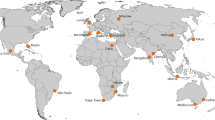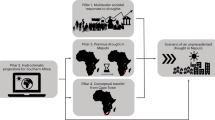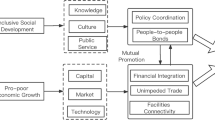Abstract
Here we test the hypothesis that local government spending on water infrastructure is associated with higher levels of economic development, and the hypothesis that this association is unequal between ethnoracial groups. Using data from the State and Local Government Finance Surveys and the US Census Bureau, we estimate a series of county-level spatial econometric models from 1980 to 2015. Our results support our hypotheses, with most beneficial associations taking 8 years to become evident. Furthermore, through the use of interactional models, we show that this effect is ethnically and racially uneven, with the benefits of investment decreasing as counties become more Latino/a and non-Latino/a Indigenous, and either increasing or decreasing as counties become more non-Latino/a Black, dependent on the specific outcome. Our results suggest that continued investment in rural water infrastructure has the potential to have wide-ranging, but possibly uneven, economic benefits for residents.
This is a preview of subscription content, access via your institution
Access options
Subscribe to this journal
Receive 12 digital issues and online access to articles
$99.00 per year
only $8.25 per issue
Buy this article
- Purchase on Springer Link
- Instant access to full article PDF
Prices may be subject to local taxes which are calculated during checkout





Similar content being viewed by others
Data availability
The raw data used to conduct this analysis are available at the Open Science Framework project page for the USDA-NIFA funded project this paper is associated with at https://doi.org/10.17605/OSF.IO/KT5MD.
Code availability
The STATA code to compile the raw data and conduct the analyses reported here is available at the Open Science Framework project page for the USDA-NIFA funded project this paper is associated with at https://doi.org/10.17605/OSF.IO/KT5MD.
References
UN Committee on Economic, Social, and Cultural Rights Resolution A/RES/64/292 General Comment No. 15: The Right to Water (United Nations, 2010).
The Value of Water Campaign (US Water Alliance, 2022); http://beta.thevalueofwater.org/the-facts/waters-value
Flora, C. B., Flora, J. L. & Gasteyer, S. P. Rural Communities: Legacy and Change (Routledge, 2018).
Tickamyer, A. R., Sherman, J. & Warlick, J. L. (eds) Rural Poverty in the United States (Columbia Univ. Press, 2017).
The American Infrastructure Report Card: Drinking Water Infrastructure (American Society of Civil Engineers, 2022); https://infrastructurereportcard.org/cat-item/drinking-water/
Greer, R. A. A review of public water infrastructure financing in the United States. Wiley Interdiscip. Rev. Water 7, e1472 (2020).
Johnson, K. M. As births diminish and deaths increase, natural decrease becomes more widespread in rural America. Rural Sociol. 85, 1045–1058 (2020).
Biden, J. President Biden’s State of the Union Address. The White House https://www.whitehouse.gov/state-of-the-union-2022/ (2022).
Emery, M. & Flora, C. Spiraling-up: mapping community transformation with community capitals framework. Community Dev. 37, 19–35 (2006).
Davis, K. M. Tainted Tap: Flint’s Journey from Crisis to Recovery (UNC Press Books, 2021).
Deitz, S. & Meehan, K. Plumbing poverty: mapping hot spots of racial and geographic inequality in U.S. household water insecurity. Ann. Am. Assoc.Geogr. 109, 1092–1109 (2019).
Fedinick, K. P. & Roberts, M. Watered down justice: communities of color and the SDWA. NRDC https://www.nrdc.org/experts/kristi-pullen-fedinick/watered-down-justice-unequalprotection-communities-color (2019).
McDonald, Y. J. & Jones, N. E. Drinking water violations and environmental justice in the United States, 2011–2015. Am. J. Public Health 108, 1401–1407 (2018).
Mueller, J. T. & Gasteyer, S. The widespread and unjust drinking water and clean water crisis in the United States. Nat. Commun. 12, Article 3544 (2021).
Roller, Z., Gasteyer, S., Nelson, N., Lai, W. & Shingne, M. Closing the Water Access Gap in the United States: A National Action Plan (Dig Deep and US Water Alliance, 2019).
Switzer, D. & Teodoro, M. Class, race, ethnicity, and justice in safe drinking water compliance. Soc. Sci. Q. 99, 524–535 (2018).
Braveman, P. A., Arkin, E., Proctor, D., Kauh, T. & Holm, N. Systemic and structural racism: definitions, examples, health damages, and approaches to dismantling: study examines definitions, examples, health damages, and dismantling systemic and structural racism. Health Aff. 41, 171–178 (2022).
Gasteyer, S. P., Lai, J., Tucker, B., Carrera, J. & Moss, J. Basics inequality: race and access to complete plumbing facilities in the United States. Du Bois Rev. 13, 305–325 (2016).
Marcillo, C. E. & Krometis, L. A. H. Small towns, big challenges: does rurality influence Safe Drinking Water Act compliance? AWWA Water Sci. 1, e1120 (2019).
Gasteyer, S. & Vaswani, R. T. Still Living without the Basics in the 21st Century: Analyzing the Availability of Water and Sanitation Services in the United States (Rural Community Assistance Partnership, 2004).
Pereira, A. M. Is all public capital created equal? Rev. Econ. Stat. 82, 513–518 (2000).
McGraw, G. Draining: The Economic Impact of America’s Hidden Water Crisis (DigDeep Report, 2022); https://static1.squarespace.com/static/5e80f1a64ed7dc3408525fb9/t/62cc6d0e5f29d403367037ff/1657564437774/Draining_+The+Economic+Impact+of+America%27s+Hidden+Water+Crisis+%5BFULL+REPORT%5D.pdf
Cassano, G. & Benz, T. A. Introduction: Flint and the racialized geography of indifference. Crit. Sociol. 45, 25–32 (2019).
Hanna-Attisha, M., LaChance, J., Sadler, R. C. & Champney Schnepp, A. Elevated blood lead levels in children associated with the Flint drinking water crisis: a spatial analysis of risk and public health response. Am. J. Public Health 106, 283–290 (2016).
Sadler, R. C. & Highsmith, A. R. Rethinking Tiebout: the contribution of political fragmentation and racial/economic segregation to the Flint water crisis. Environ. Justice 9, 143–151 (2016).
Meehan, K. et al. Exposing the myths of household water insecurity in the global north: a critical review. Wiley Interdiscip. Rev. Water 7, e1486 (2020).
Meehan, K., Jurjevich, J. R., Chun, N. M. & Sherrill, J. Geographies of insecure water access and the housing–water nexus in US cities. Proc. Natl Acad. Sci. USA 117, 28700–28707 (2020).
Flowers, C. C. Decreased food and water intake attributable to failing sanitation in the United States. Am. J. Public Health 108, 1269 (2018).
Flowers, C. C. Waste: One Woman’s Fight Against America’s Dirty Secret (The New Press, 2020).
Winkler, I. T. & Flowers, C. C. America’s dirty secret: the human right to sanitation in Alabama’s Black Belt. Columbia. Hum. Rights Law Rev. 49, 181 (2017).
Rural Water Infrastructure: Additional Coordination Can Help Avoid Potentially Duplicative Application Requirements GAO-13-111 (US Government Accountability Office, 2012).
Pigg, K., Gasteyer, S. P., Martin, K. E., Keating, K. & Apaliyah, G. P. The community capitals framework: an empirical examination of internal relationships. Community Dev. 44, 492–502 (2013).
Anand, N. Municipal disconnect: on abject water and its urban infrastructures. Ethnography 13, 487–509 (2012).
Rodgers, D. & O’Neill, B. Infrastructural violence: introduction to the special issue. Ethnography 13, 401–412 (2012).
Balazs, C. L. & Ray, I. The drinking water disparities framework: on the origins and persistence of inequities in exposure. Am. J. Public Health 104, 603–611 (2014).
Oliver, M. L. & Shapiro, T. M. Disrupting the racial wealth gap. Contexts 18, 16–21 (2019).
Wilson, W. J. The political and economic forces shaping concentrated poverty. Polit. Sci. Q. 123, 555–571 (2008).
Helling, A. & Sawicki, D. S. Race and residential accessibility to shopping and services. Hous. Policy Debate 14, 69–101 (2003).
Kwate, N. O. A. Fried chicken and fresh apples: racial segregation as a fundamental cause of fast food density in black neighborhoods. Health Place 14, 32–44 (2008).
Kwate, N. O. A., Loh, J. M., White, K. & Saldana, N. Retail redlining in New York City: racialized access to day-to-day retail resources. J. Urban Health 90, 632–652 (2013).
1983 Rural Urban Continuum Codes (USDA-ERS, 2004); https://www.ers.usda.gov/data-products/rural-urban-continuum-codes.aspx
Lichter, D. T. & Johnson, K. M. In Investing in Rural Prosperity. Federal Reserve Band of St. Louis 67–80 (eds Dumont A. & Davis P.) (2021).
Brown, D. L. & Schafft, K. A. Rural People and Communities in the 21st Century: Resilience and Transformation 2nd edn (Polity, 2019).
Thiede, B., Kim, H. & Valasik, M. The spatial concentration of America’s rural poor population: a postrecession update. Rural Sociol. 83, 109–144 (2018).
Johnson, K. M. Rural America Lost Population Over the Past Decade for the First Time in History Carsey Institute National Issue Brief 160 (Univ. New Hampshire, 2022).
Government Finance and Employment Classification Manual (US Census Bureau, 2006).
Manson, S., Schroeder, J., Van Riper, D., Kugler, T. & Ruggles, S. IPUMS National Historical Geographic Information System: version 16.0. IPUMS https://doi.org/10.18128/D050.V16.0 (2021).
Isserman, A. M. In the national interest: defining rural and urban correctly in research and public policy. Int. Reg. Sci. Rev. 28, 465–499 (2005).
Lobao, L. & Kelly, P. Local governments across the rural–urban continuum: findings from a recent national county government study. State Local Gov. Rev. 51, 223–232 (2019).
Lobao, L. & Kraybill, D. S. The emerging roles of county governments in metropolitan and nonmetropolitan areas: findings from a national survey. Econ. Dev. Q. 19, 245–259 (2005).
Schroeder, J. P. & Pacas, J. D. Across the rural–urban universe: two continuous indices of urbanization for US Census microdata. Spat. Demogr. 9, 131–154 (2021).
Brady, D. Rethinking the sociological measurement of poverty. Social Forces 81, 715–751 (2003).
CPI Inflation Calculator (Bureau of Labor Statistics, 2022; https://data.bls.gov/cgi-bin/cpicalc.pl
von Hippel, P. T., Scarpino, S. V. & Holas, I. Robust estimation of inequality from binned incomes. Sociol. Methodol. 46, 212–251 (2016).
Mueller, J. T. Natural resource dependence and rural American economic prosperity from 2000 to 2015. Econ. Dev. Q. 36, 160–176 (2020).
Thiede, B. C., Butler, J. L., Brown, D. L. & Jensen, L. Income inequality across the rural–urban continuum in the United States, 1970–2016. Rural Sociol. 85, 899–937 (2020).
Cresce, A. R., Schmidley, A. D. & Ramirez, R. R. Identification of Hispanic Ethnicity in Census 2000: Analysis of Data Quality for the Question on Hispanic Origin (Population Division, US Census Bureau, 2004).
Brooks, M. M., Mueller, J. T. & Thiede, B. C. Rural-urban differences in the labor-force impacts of COVID-19 in the United States. Socius 7, 1–12 (2021).
Johnson, K. M. & Lichter, D. T. Metropolitan reclassification and the urbanization of rural America. Demography 57, 1929–1950 (2020).
Halleck Vega, S. & Elhorst, J. P. The SLX model. J. Reg. Sci. 55, 339–363 (2015).
LeSage, J. & Pace, R. K. Introduction to Spatial Econometrics (Chapman and Hall/CRC, 2009).
Acknowledgements
This study was supported by the United States Department of Agriculture, National Institute of Food and Agriculture, Agriculture and Food Research Initiative under grant 2022-67023-36536 to S.G. and J.T.M.
Author information
Authors and Affiliations
Contributions
J.T.M.: conceptualization, methodology, formal analysis, writing—original draft, writing—review and editing, visualization, funding acquisition. S.G.: conceptualization, writing—review and editing, supervision, project administration, funding acquisition.
Corresponding author
Ethics declarations
Competing interests
The authors declare no competing interests.
Peer review
Peer review information
Nature Sustainability thanks Yolanda McDonald and Leigh-Anne Krometis for their contribution to the peer review of this work.
Additional information
Publisher’s note Springer Nature remains neutral with regard to jurisdictional claims in published maps and institutional affiliations.
Supplementary information
Supplementary information
Supplementary Tables 1–10 and Figs. 1–3.
Rights and permissions
Springer Nature or its licensor (e.g. a society or other partner) holds exclusive rights to this article under a publishing agreement with the author(s) or other rightsholder(s); author self-archiving of the accepted manuscript version of this article is solely governed by the terms of such publishing agreement and applicable law.
About this article
Cite this article
Mueller, J.T., Gasteyer, S. The ethnically and racially uneven role of water infrastructure spending in rural economic development. Nat Water 1, 74–82 (2023). https://doi.org/10.1038/s44221-022-00007-y
Received:
Accepted:
Published:
Issue Date:
DOI: https://doi.org/10.1038/s44221-022-00007-y
This article is cited by
-
Uneven benefits of infrastructure spending among ethnoracial groups
Nature Water (2023)



